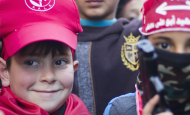UN Secretary-General Report on Children and Armed Conflict: Clear Departure from NGO Propaganda Against Israel
On June 27, 2018, the United Nations Secretary-General (UNSG) published his 2017 report on Children and Armed Conflict. Intensive lobbying by non-governmental organizations (NGOs), led by Human Rights Watch (HRW), to include the IDF on the list of “grave violators” of child’s rights (included as an Annex) failed. In addition, for a UN publication, the report presents a relatively balanced portrayal of events in Israel, the West Bank, and Gaza.
For years, NGOs such as Watchlist, HRW (which is also part of the Watchlist coalition), Defense for Children International – Palestine (DCI-P), Amnesty International, Addameer, B’Tselem, HaMoked, and Military Court Watch have engaged in misinformation campaigns alleging “systematic” violations committed by Israeli forces against Palestinian minors – in an attempt to trigger the IDF’s listing in the Annex. Groups currently listed in the Annex include ISIS, the Taliban, and Boko Haram, which are subjected to UN Security Council measures such as sanctions.
UNICEF also plays a role in this campaign. Its regional branch, known as “UNICEF-oPt,” partners with a number of the organizations mentioned above, as well as with other additional groups that promote anti-Israel demonization and/or have ties to terror groups.1 UNICEF-oPt’s NGO partners publish misleading and false reports on the treatment of Palestinian minors involved in attacks and arrested by the IDF, rife with distortions and inaccuracies and devoid of necessary context. These same erroneous and unverified claims are then laundered through a UNICEF database to a variety of UN publications, lending them legitimacy and prominence.
NGO Monitor analysis notes the following points where the UNSG’s report echoes NGO/UNICEF distortions:
- The report states that 15 Palestinian children were killed by Israeli forces during 2017, noting that five of these deaths occurred while the minor was perpetrating a stabbing attack (sources are not provided, but identical numbers are given by DCI-P and B’Tselem). The UNSG’s report however fails to note the violent clashes, car ramming attacks, and incidents of throwing Molotov cocktails that resulted in the deaths of many of the other ten minors.
- Claims that “a number of cases raise concerns regarding the excessive use of force by Israeli forces,” citing a July 21 incident when a “17-year-old boy” from Abu Dis was killed while participating in stone-throwing. As opposed to DCI-P’s claim, Israeli media reports gave his age as 18 (and therefore not a minor).
- In his recommendations, the UNSG mentions that Israel should “refrain from the use of solitary confinement.” This claim echoes the false claim made in UNICEF’s 2013 “Children in Israeli Military Detention” report (and repeatedly by DCI-P). In reality, Israel does not hold minor suspects in solitary confinement, defined as physical isolation in a cell for 22 to 24 hours per day (para. 77). When children are held in a cell alone this is due to an adherence to international and domestic law that forbids minors from being held with the adult population. Therefore, if a sole minor is arrested, they must be held separately.
In contrast to the one-sided NGO campaigns that erase Israeli human rights and Palestinian violations, the Secretary General’s report mentions incidents where Israeli children were targeted. NGO Monitor notes the follow points where the UNSG’s report departs from standard NGO narratives:
- Unlike UNICEF and its NGO partners, which rarely, if ever, note violations committed by Palestinians against Israeli minors, the UNSG report notes such instances. For example, the UNSG notes that five Israeli children were injured in Jerusalem.
- Notes that one Israeli school and one Gaza school were attacked by rockets fired by Palestinian armed groups. UNICEF’s NGO partners and UNICEF itself regularly ignore attacks on Israeli schools and/or by Palestinian armed groups.
- Explains that two terror tunnels were found under UN schools in Gaza.
- It appears that the UNSG performed some verification of UNICEF and NGO claims. For example, it did not include baseless claims from UNICEF’s 2017 situation reports, that there were “1,022 incidents of grave violations against children.”
Human Rights Watch’s Bitter Response
Even after it failed to sway the UNSG to list Israel, HRW released a statement complaining that he was “ignoring or downplaying some countries’ abuses” (“UN: Dangerous Double Standard on Children in Conflict”). Tellingly, HRW’s account completely erases attacks against Israeli children, merely claiming that “Israeli forces killed at least 15 Palestinian children…” and that “four schools also suffered damage in Gaza in the context of Israeli airstrikes.” As opposed to the UNSG report, HRW does not note that 5 of the 15 were killed while perpetrating stabbing attacks against Israelis, and that one Israeli school and one Gaza school were attacked by Palestinian armed groups’ rockets. Furthermore, the UNSG report adds broader relevant context, acknowledging that the four Gaza schools “suffered minor damage in Gaza in the context of Israeli air strikes, reportedly in response to projectiles launched by Palestinian armed groups in Gaza” (emphasis added).
HRW also disingenuously laments, “the UN also fails to list… Palestinian groups as parties responsible for violations against children.” However, in their submissions to the UNSG, HRW and Watchlist completely ignore violations committed by Palestinian armed groups. More importantly, they did not issue any recommendation to list them in the UNSG report.
Footnotes
- Several of the Palestinian groups – including Defense for Children International-Palestine (DCI-P) and Addameer, which play a leading role in this campaign – have close links to the Popular Front for the Liberation of Palestine (PFLP) – listed as a terrorist organization by the US, EU, Canada, and Israel. UNICEF-oPt states, “UNICEF has a clear policy that is does not fund support (sic) organizations which are listed as terrorist organizations by the United Nations” – a list that excludes Hamas, the PFLP, and Islamic Jihad.

